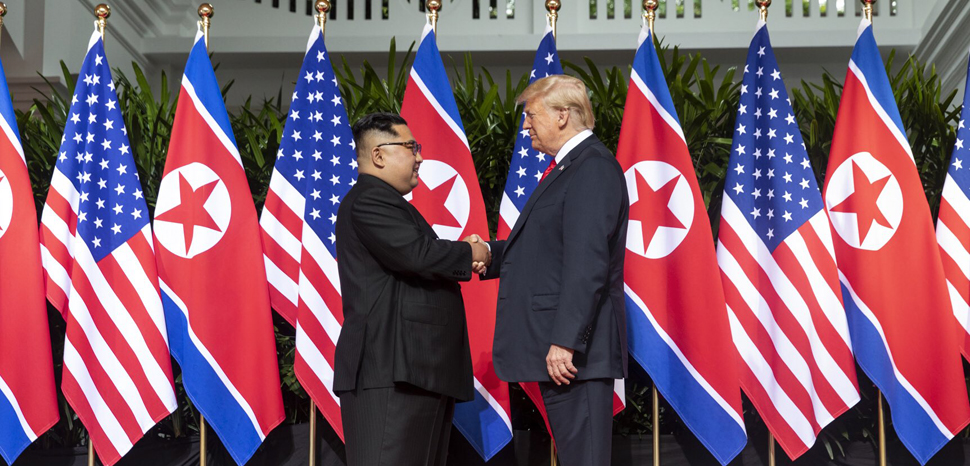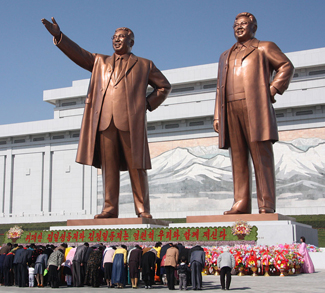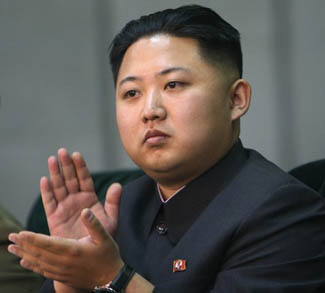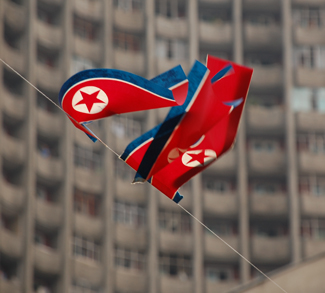The Democratic People’s Republic of Korea is a historical anomaly within international politics and security. Considered a backwater, renegade, and impoverished country by the United States and much the international community, North Korea has managed to maximize its strategic leverage. North Korean diplomatic initiatives have involved extorting international humanitarian aid, undermining United States security measures and partnerships in proximity to the Korean Peninsula, utilizing blackmail as a diplomatic option, and fostering the development of a nuclear weapons program with a range that has given rise to a new security crisis for various historical adversaries.
The acquisition of nuclear weapons by Pyongyang is essential to regime sustainability; it protects the Kim dynasty from threats foreign and domestic, and can be wielded as a diplomatic tool against the United States, South Korea, Japan, and China. While garnering international attention with grandiose nuclear threats and theatrical military parades, North Korea continues to covertly modernize its arsenal, develop second-strike capabilities, and complicate relations between the United States and China, all while slowly achieving the status of an internationally recognized nuclear-armed state, capable of deterring the United States, and in a stronger position to negotiate the future of the Korean Peninsula.
The wielding of nuclear weapons is paramount to the legitimacy of the North Korean regime in the modern era in relation to its neighboring foes and its near abroad foe: The United States. The diplomatic strategy of the DPRK comprises of three main pillars: the status of the DPRK within the international community, the termination of the hostile actions the United States conducts toward Pyongyang in the form of US-South Korea military exercises and economic sanctions, and political settlements for the Korean Peninsula that include eventual reunification of Korea into a single polity. For all three foundations to the North Korean diplomatic effort to succeed, the possession of a robust nuclear arsenal, including second-strike capabilities, is essential to accomplishing all three objectives.
DPRK diplomatic strategy
North Korean diplomacy is ingrained in the strategic culture of the country. It is infused with the myths and lore of the Kim family and the sustained psychological trauma of the legitimization of Japanese occupation via the 1905 Portsmouth Treaty and 1919 Treaty of Versailles. This trauma from Japanese occupation, Korean independence, and the Korean War are the three main sources of public diplomacy coercion by the Kim dynasty, to be wielded not just internationally, but domestically against the citizens of the DPRK. The number one objective for the DPRK’s diplomatic strategy is the survival of the Kim regime through the paradox of stabilized instability. According to this paradox, whenever the Kim dynasty believes that the United States and South Korea are considering a pre-emptive assault on the DPRK, Pyongyang will seek to diplomatically defuse tensions, all while covertly advancing North Korea’s nuclear arsenal. Conversely, Pyongyang when is confident in the power of its nuclear deterrence mechanisms, North Korea becomes more assertive in its claims against the United States, Japan, and South Korea. To bolster the legitimacy of the Kim dynasty as sole authority and sovereign on the peninsula, being recognized as a nuclear state is paramount.
For Pyongyang, recognition as a nuclear state, despite its economic realities, must be secured from South Korea, the United States, China, Russia, and Japan to elevate the stature of North Korea as a great power peer in international relations and security. In light of the fact that recognition as a nuclear power from China, Russia, South Korea, and Japan has not been garnered, the Singapore diplomatic summit between Kim Jung-un and President Donald Trump was a strategic maneuver by Pyongyang to secure international recognition of North Korea as a nuclear armed state without any agreements of substantial concessions that could potentially undermine the political legitimacy of the Kim regime. Evan Medeiros, former Director of U.S. National Security Council for Asia under President Barack Obama stated that the Singapore summit validated and advanced “Kim’s goal of being recognized as a de facto nuclear state.” The legitimacy of the Kim dynasty was heightened with Pyongyang positioning itself as an international negotiating power determining the future of the Korean Peninsula, including the process and scope of denuclearization. For North Korea, demilitarization involves the complete withdrawal of the United States from East Asia, diminishing the presence of U.S. anti-ballistic missile defense systems, and the disavowal of the U.S. security and nuclear defense guarantees for South Korea and Japan. These diplomatic successes are featured prominently in domestic propaganda to bolster national loyalty and obedience to the Kim dynasty.
Emphasis on the necessity of a nuclear arsenal only grew amid US military interventions in Iraq, Libya, and the Balkans. For Pyongyang, the surrendering of nuclear weapons tended to portend a grim fate: military intervention and regime change by the United States and coalition forces. In 2018, Kim Jong-un emphasized in a speech that “as a responsible nuclear weapons state, our Republic will not use a nuclear weapon unless its sovereignty is encroached upon by an aggressive hostile force with nukes.”
More importantly, just as nuclear weapons are meant to deter the United States and coerce South Korea toward favorable peninsula reunification terms, so too are DPRK nuclear weapons utilized to coerce and deter the Chinese and Russians. North Korean mistrust toward Beijing stems from 1964 when Mao Zedong denied the request of Kim Il-Sung to acquire Chinese nuclear military technology and the Soviet abandonment of Cuba during the Cuban Missile Crisis.
Political legitimacy is further bolstered through the establishment of a balance of power with Washington, namely through the upending of American security agreements in the region via a combination of North Korean bilateral initiatives and nuclear provocations. The possession of nuclear weapons represents a double-pronged strategy to portray an image to the Korean populace that Kim Jung-un is infallible, omnipotent, and represents the only figure able to dictate the affairs of the Korean peninsula.
DPRK nuclear diplomacy
Part of this coercive strategy includes highlighting and testing the DPRK’s nuclear program to heighten Pyongyang’s strategic gains in the military sphere, fueling an international crisis that ultimately necessitates diplomatic summits between North Korea and regional and global powers. By precipitating these summits, North Korea contorts the international political arena into a satisfactory condition that favors the advancing of Pyongyang’s national security and strategic interests over the Peninsula. The main strategic interest for Pyongyang regarding the Korean Peninsula is to force the United States into a position that acknowledges North Korea as a nuclear power and to reverse America’s multilateral diplomatic approach within the Six-Party Talks by conducting increased bilateral engagement with China and Russia.
Pyongyang’s coercive nuclear diplomacy is changing the dynamics of regional security talks and placing the United States in a position where it is now openly questioning the wisdom of strategic patience. Such doubts stem from the idea that continual sanctions are ineffective in containing North Korea and destabilizing the Kim regime, as Pyongyang consistently reroutes economic pressures through nuclear intimidation and strategic threats that could also affect Chinese and Russian regional interests, bringing the United States into strategic conflict with Beijing and Moscow.
Moments of coercive diplomatic success on the part of the DPRK are seen in the rapprochement between Seoul and Pyongyang amid the revelation of North Korean ICBM capabilities that can target the mainland United States. With new national security dangers to mainland United States, South Korean opinions have shown indications of support toward an independent policy for stability on the Korean Peninsula between Seoul and Pyongyang, including increased support for a unified Korea with an alliance with China.
For Pyongyang, deployment of coercion and nuclear diplomacy is more about the survival and longevity of the DPRK’s political institutions. Insistence on nuclear weapons as a diplomatic tool and a strategic military asset is further exacerbated by the Kim Jong-Il policy of Songun, or ‘military-first’ policy, and the Kim Jong-un policy of Byungjin, which is the parallel development of the North Korean economy and nuclear program.
Between the two military-first policies of Songun and Byungjin, the diplomatic priorities of Pyongyang are to guarantee the regional permanence and global legitimacy of the Kim regime. Through the military-first lens of North Korea’s diplomatic efforts, there are three main goals: manipulate the regional geopolitical environment by negotiating deterrence with the United States, engage in public diplomacy for economic expansion, and pursue bilateral rapprochement with South Korea to acquire vital economic aid for political survival. North Korea asserts that its military-first diplomatic approach is “the strongest measure of unification our generation can use to realize our nation’s long-cherished wish for unification…it hinders the United States’ attempts at wars of aggression and thus provides the fundamental setting for a peaceful environment for our nation’s unification.” The nuclear diplomatic posturing of North Korea will remain a primary method of ensuring the survival of the Kim dynasty until Pyongyang is capable of acquiring physical guarantees to its political system against the United States and neighboring hostile countries.
The physical guarantees are realized when North Korea is officially recognized as a nuclear power and invited to participate in international nuclear arms reduction summits, while simultaneously receiving economic security through aid, bilateral agreements, connectivity to global international trading, and international financial institutions without having to denuclearize. However, just as the DPRK seeks entry into the international system and recognition as a nuclear armed state, so too does North Korea understand that the opening of the economy and decentralization of financial institutions directly threatens the state-owned economy and, therefore, the totalitarian system as a whole.
Pyongyang’s diplomatic successes are reinforced by strategic deception and projecting an image of a reasonable cooperative partner. By issuing continual promises to engage and return to diplomatic talks with the United States and regional neighbors, North Korea appears more than willing to negotiate; however, it simultaneously is rejecting diplomatic preconditions that are deemed averse to its core interests. Through this diplomatic strategy, North Korea utilizes control over diplomatic initiatives and summits with the United States and neighboring countries, determining through raising tensions what outcomes are desirable for Pyongyang without having to make any concessions that negatively impact the legitimacy and stability of the Kim regime domestically.
On consistent theme is that Pyongyang has historically sought to advance various ambitious demands, including the end of US-South Korean military exercises; removal of bilateral defense agreements between the United States and South Korea; dismantling of the United States nuclear arsenal and reduction of extended-deterrence guarantee to Japan; establishment of formal diplomatic relations with the United States; removal of all United Nations, United States, and European Union sanctions; and suppression of publications in South Korea that reflect anti-DPRK public sentiment.
As much as nuclear diplomacy and coercion are the preferred modus operandi of the Kim dynasty, its usage has a domestic factor as well. The longevity of the Kim regime is dependent upon the subjugation of the people and the obedience of the military to the protection and veneration of the god-like personification of the Kim family. The establishment of the North Korean Strategic Rocket Force in 2014, and the declaration that it falls under the direct control of the Workers’ Party of Korea through the Central Military Commission, shows how Kim Jung-un is dependent on public displays of progress in the DPRK’s nuclear weapon modernization efforts. Such efforts act as a deterrent mechanism, not necessarily against foreign actors, but against the North Korean populace and military officials that may otherwise have questionable loyalty to the regime.
Reunification: the ultimate goal of DPRK nuclear diplomacy
North Korean diplomacy is meant to pave a route to political settlements regarding the future of the Korean Peninsula, with North Korea recognized as a fully independent signatory on equal footing and stature with the United States. One-sided bilateral negotiations with the United States have the goal of signing an official peace treaty to end the Korean War while North and South Korea negotiate peninsula security assurances, including the dismissal of the United States despite the United States and South Korea expanding political agreements to include a partnership in energy and health security and the economic elevation of women in 2018. Not only is North Korean diplomacy directed at depicting Pyongyang as capable of directly challenging the United States, but it’s also meant to demonstrate independence from Beijing. Since the 1961 Sino-North Korean Treaty of Friendship, Cooperation, and Mutual Assistance, Beijing has been required to come to the defense of North Korea in the event of direct warfare between the DPRK, South Korea, and the United States; however, Beijing has proclaimed that China will remain neutral if North Korea instigates war with the United States.
Since North Korea has remained skeptical of the allegiance and priorities of China since 1964, North Korean nuclear diplomacy is directed at China as well: forcing Beijing to incorporate security and peace on the Korean Peninsula into Chinese national security, and to counterbalance the United States in the region. The implications of a failed North Korean political system, which could result in mass migrations across the Yalu River into China in addition to indiscriminate nuclear warfare and economic destabilization of the region, make the fate of North Korea a strategic imperative for China. This puts China in a position of having to defend Pyongyang politically and economically, and creates hesitance in Beijing to support additional sanctions against the DPRK.
With the end of diplomatic efforts between the United States and North Korea, the DPRK has increased efforts in nuclear weapon production and modernization, military parades, and prioritized ICBM development. Furthermore, in a display of coercive public diplomacy, North Korea demolished the Inter-Korean Joint Liaison Office – a provocative statement that “abandons the hopes of everyone who wanted the development of inter-Korean relations and peace settlement in the Korean Peninsula.” By ramping up military tensions on the Korean Peninsula, Pyongyang is repositioning itself yet again into a negotiating stance of attempting to acquire international aid and attention while promoting the political security of the Kim dynasty.
The central goal of North Korea’s coercive diplomacy is to support political legitimacy and international recognition of the Kim dynasty, casting it as sole sovereign political entity within North Korea and a unifier of the Korean Peninsula. The diplomatic approach is designed to be multifaceted in its intended audience, adjusting as needed to shifting dynamics between the domestic population of Korea, the United States, Japan, China, and Russia. The utilizing of nuclear weapons is more focused on preserving and guaranteeing permanence of the Kim dynasty, and as a deterrence tool against the United States, rather than a first-strike option. DPRK strategic deception as a diplomatic tool undermines US strategic patience while nuclear advances stress American-ROK, American-Japanese, and Sino-American security and economic relationships, allowing Pyongyang to unravel multilateral containment strategies promoted by the United States and strengthen North Korean bilateral initiatives that elevate the DPRK to a nuclear-armed great power peer in the international arena.
The views expressed in this article are those of the authors alone and do not necessarily reflect those of Geopoliticalmonitor.com or any institutions with which the authors are associated.




